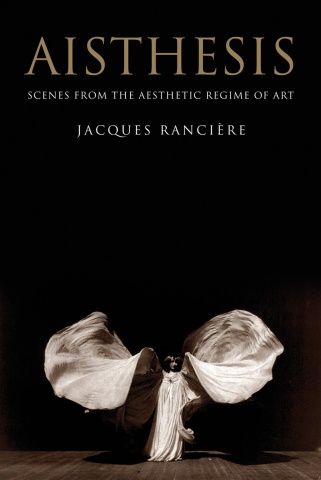Jacques Rancière: Aisthesis: Scenes from the Aesthetic Regime of Art (2011/2013)
Filed under book | Tags: · aesthetics, art, art history, art theory, body, cinema, dance, film, life, literature, music, painting, pantomime, philosophy, photography, poetry, politics, representation, sculpture, theatre, theory

Rancière’s magnum opus on the aesthetic.
“Composed in a series of scenes, Aisthesis–Rancière’s definitive statement on the aesthetic–takes its reader from Dresden in 1764 to New York in 1941. Along the way, we view the Belvedere Torso with Winckelmann, accompany Hegel to the museum and Mallarmé to the Folies-Bergère, attend a lecture by Emerson, visit exhibitions in Paris and New York, factories in Berlin, and film sets in Moscow and Hollywood. Rancière uses these sites and events—some famous, others forgotten—to ask what becomes art and what comes of it. He shows how a regime of artistic perception and interpretation was constituted and transformed by erasing the specificities of the different arts, as well as the borders that separated them from ordinary experience. This incisive study provides a history of artistic modernity far removed from the conventional postures of modernism.”
First published as Aisthesis : Scènes du régime esthétique de l’art, Éditions Galilée, 2011
Translated by Zakir Paul
Publisher Verso Books, 2013
ISBN 1781680892, 9781781680896
304 pages
via falsedeity
Reviews: Hal Foster (London Review of Books), Joseph Tanke (Los Angeles Review of Books), Marc Farrant (The New Inquiry), Ali Alizadeh (Sydney Review of Books), Jean-Philippe Deranty (Parrhesia).
Roundtable discussion with Rancière at Columbia (video, 43 min)
Selected interviews and reviews (in French)
Sešit pro umění, teorii a příbuzné zóny (2007–) [Czech]
Filed under journal | Tags: · activism, aesthetics, art, art history, art theory, contemporary art, curating, czech republic, participation, theory



“Sešit pro umění, teorii a příbuzné zóny je periodikum zaměřující se na současné vizuální umění v širším kulturním a teoretickém kontextu. Cílem Sešitu je kultivovat domácí reflexi umění tištěním odborných textů z oblasti humanitních a společenských věd, které tematizují současnou situaci umění a živé kultury u nás i v zahraničí. Sešit z principu není metodologicky vymezen; rozhodujícími měřítky jsou kvalita, podnětnost a relevance pro reflexi současného vizuálního umění.”
Edited by Václav Magid
Editorial board: Claire Bishop, Claudia Joles, Tomáš Pospiszyl, Jiří Ševčík, Martin Škabraha
ISSN 1802-8918
Issue 1-2 (2007, single PDF, texts by Patricie C. Phillips and Peter Bürger are missing)
Issue 4-5 (2008, single PDF, 75 MB, texts by Jonathan Crary and Steven Best/Douglas Kellner are missing, added on 2014-2-10)
Issue 8 (2010, single PDF)
Issue 9 (2010, single PDF)
Issue 10 (2011, single PDF, added on 2014-2-10)
Issue 11 (2011, single PDF, added on 2014-2-10)
Selected texts in PDF
Jeffrey R. Di Leo, Uppinder Mehan (eds.): Terror, Theory and the Humanities (2012)
Filed under book | Tags: · aesthetics, education, film, philosophy, terrorism, theory, war on terror

The events of September 11, 2001, have had a strong impact on theory and the humanities. They call for a new philosophy, as the old philosophy is inadequate to account for them. They also call for reflection on theory, philosophy, and the humanities in general. While the recent location and killing of Osama bin Laden, the leader of al-Qaeda, in Pakistan on May 2, 2011—almost ten years after he and his confederates carried out the 9/11 attacks—may have ended the “war on terror,” it has not ended the journey to understand what it means to be a theorist in the age of phobos nor the effort to create a new philosophy that measures up with life in the new millennium. It is in the spirit of hope—the hope that theory will help us to understand the age of terror—that the essays in this collection are presented.
With essays by Christian Moraru, Terry Caesar, David B. Downing, Horace L. Fairlamb, Emory Elliott, Elaine Martin, Robin Truth Goodman, Sophia A. McClennen, William V. Spanos, Zahi Zalloua.
Publisher Open Humanities Press, an imprint of MPublishing, University of Michigan Library, Ann Arbor
Critical Climate Change series
Creative Commons Attribution Share Alike 3.0 License
ISBN 1607852497, 9781607852490
248 pages
PDF
View online (HTML)

